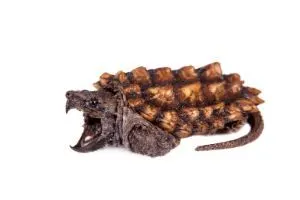There are several types of aggressive turtles out there and some bite worse than others. Being bitten by a turtle may not seem like a big deal but it is important to remember that turtles carry salmonella.
As such, even when the bite doesn’t break the skin, you need to thoroughly wash your hands and the affected area with water and soap.
Of course, some turtles can bite pretty hard. While, some turtles are more prone to biting. As you may already know, turtles aren’t pets that you are supposed to handle or touch frequently.
The only times you have to handle your turtle are when it is needed. Some turtles will bite when handled. Softshell turtles and snapping turtles are known to be aggressive and are likelier to bite.
What Turtles Are Aggressive?
Most Aggressive Turtles
Every turtle has a distinct personality. As such, even a feisty and aggressive species like the eastern musk turtle can be docile.
If your pet turtle has a feisty personality then it is best not to handle it often. Here are turtle species that are known for their aggressive nature.
Regardless of a turtle’s species, you must handle them with care. Turtles generally don’t like being handled.
You should avoid picking up or handling wild turtles. Some turtles such as snappers should not be approached in the wild.
Snapping turtles
The turtle with the worst bite gotta be the snapping turtle. There are actually two species of snapping turtles, these include the alligator snapping turtle (Macrochelys temminckii) and the common snapping turtle (Chelydra serpentina).
Both turtles have strong bites and as such are appropriately named. Snapping turtles are native to North America. These two species are the only two extant members of the family Chelydridae.
These turtles are also known for their aggressive nature. Funny enough, these turtles are not aggressive when in water. I believe they aren’t aggressive underwater as they can easily swim away.
On land, they are rather slow and as such bite as a defensive mechanism. Both turtles are apex predators although humans are known to hunt them.
1. Alligator snapping turtle

The alligator snapping turtle can be found in the southeastern U.S. As these turtles are aquatic, they spend most of their time in waters.
They are native Florida, Texas, Kansas, Missouri, Iowa, Illinois, Indiana, Kentucky, and Tennessee. These aquatic turtles spend all their lives in aquatic habitat. Only the females come on open land, and that’s only to lay eggs.
This turtle has a large head with a sharp hooked beak which delivers powerful bites. The shell of this turtle is thick with three distinct ridges that look like the rough ridged skin of an alligator, thus its common name.
2. Common snapping turtle

This turtle can be found from southeastern Canada to Florida. They have a large native geographical range which also extends inwards to the Rocky Mountains.
These turtles are rugged-looking with their rigid carapace. The ridges on the common snapping turtle’s shell are nowhere as prominent as that of the alligator snapping turtle.
The bite force of snappers
Between the two turtles, the alligator turtle possesses a more dangerous bite according to data available.
There have been at least three documented cases of alligator snapping turtle amputating human fingers. As you can tell, these aren’t to be messed with.
Common snapping turtles can also bite hard enough to cause serious lacerations. The common snapping turtle has a jaw strength of 208 to 226 newtons.
This is nothing compared to humans who possess a bite force of 300 to 700 newtons. However it’s important to remember that snappers don’t have teeth, instead, they have beaks with very sharp cutting edges. These knife-like beaks are formidable biting tools.
3. Softshell turtles

These carnivorous turtles are rather aggressive and will bite you if given the chance – that is when handled or restrained.
Interestingly, softshell turtles do not have sharp beaks. In fact, they do not have beaks at all. Yet they are capable of delivering very painful bites.
Softshell turtles belong to the family Trionychidae. These are many extant softshell turtle species with the most popular genus being the genus Apalone.
This genus includes the species such as Apalone ferox (Florida softshell turtle), Apalone mutica (smooth softshell turtle), and Apalone spinifera (spiny softshell turtle). All three species are relatively popular among turtle parents (keepers).
Instead of a hard bony shell, softshell turtles have tough leathery shells, thus their common name. They also possess snorkel-like snouts.
The bite of a softshell turtle
Softshell turtle turtles are different from other turtles as they don’t have beaks. Instead, they possess extremely powerful jaws.
As carnivorous animals, they crush mollusks, fish, crustaceans, and other animals with their jaw. There have been documented cases of serious softshell turtle bites.
In Malaysia – specifically Muar, there was a reported case of a Malayan softshell turtle (Dogania subplana) biting off a huge chunk of a local fisherman’s nose.
All softshell turtles can lacerate human skin with their bites. As such, it is best to be careful when handling them.
According to the 2002 study on turtle bite performances – Evolution of bite performance in turtles, the Apalone ferox has a bite force of 41.50 Newtons.
4. Musk turtles

Musk turtles belong to the genus Sternotherus. These turtles are generally aggressive. They are regularly captive bred and are quite common in captivity.
Popular musk turtles include the razorback musk turtle (Sternotherus carinatus) and the stinkpot also known as the common musk turtle (Sternotherus odoratus).
The bite of a musk turtle
While quite innocuous-looking, musk turtles can deliver powerful and painful bites. The razorback musk turtle has a bite force of around 109 N (± 56 N), while the common musk turtle has a bite force of 31 N (± 19 N).
As musk turtles can be quite aggressive, they aren’t the best turtles for young kids.
5. Pond Slider turtles

Sliders are very popular. Many different subspecies are generally kept as pets; these include the red-eared slider and the yellow-bellied slider. These turtles are native to the United States and Mexico.
The red-eared slider has a geographic range that stretches from Alabama all the way to northern Mexico.
Cumberland sliders are native to the Appalachian Mountains, while the yellow-bellied sliders are native to southern Virginia and the northern border of Florida.
The bite of a pond slider turtle
Pond sliders don’t possess powerful bite forces. They possess a bite force of about 18 N (± 8.5 N). As juveniles, the pond sliders are carnivorous and as such have strong jaws and sharp beaks to hunt and feed.
As such, they possess painful bots. While their bites usually do not cause lacerations, it’s best to avoid getting bitten by a pond slider. A bite from an adult red slider can cause a lot of bleeding and pain.
6. Mud turtles

Mud turtles belong to the genus Kinosternon and are closely related to musk turtles. In fact, both belong to the same taxonomic family Kinosternidae.
Just like musk turtles, mud turtles are generally aggressive. These American turtles are commonly bred and make great pets. However, be wary of their sharp beaks.
The bite of a mud turtle
The most popular mud turtle kept as pets is the eastern mud turtle (Kinosternon subrubrum) also known as the common mud turtle.
These turtles have a bite force of about 35 N. The scorpion mud turtle also has a bite force of 38 N (± 17 N).
7. Box turtles

Box turtles are North American turtles that belong to the genus Terrapene. Although these turtles are terrestrial they still belong to the American pond turtle taxonomic family Emydidae.
These turtles have high domes just like tortoises and can even retract fully and close off their shell. These turtles are generally not aggressive and as such are popular.
The most common box turtle kept as pets are the Common box turtle (Terrapene carolina) and its subspecies which include the Florida box turtle (T. c. bauri) and the Eastern box turtle (T. c. carolina).
The bite of a box turtle
Box turtles may bite when threatened although this is rare. Their bites can be quite painful, especially to a young child. However, it is important to remember that these turtles hardly ever bite. The Terrapene carolina has a bite force of 25 N (± 8 N).
Conclusion
Softshell turtles and snappers are more likely to bite and these turtles can deliver very painful bites. Snapping turtles are even capable of amputating a finger. Now, that’s bite force.
Even commonly kept turtle species such as cooters, yellow-bellied sliders and red-eared sliders can bite when scared.
Regardless of this, turtles from all species can bite. Turtles have different personalities and as such aggressive nature can differ from one individual turtle to another.
To prevent bites try not to handle the turtle often. Similarly, try not to hand feed the turtle as it may come to think that your fingers are food and may attempt to bite them when you need to pick them up.
If you have more to add or questions to ask, please leave a comment below.
